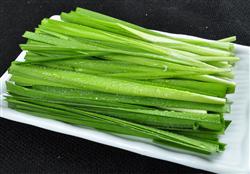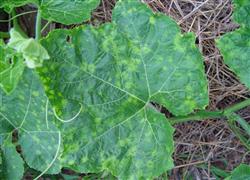Leek planting: why the leek withered leaves? How to prevent and cure

Why are the leeks withered? How to prevent and cure it? Please introduce the causes and control methods. Leaf drying often occurs during the growing period of leek, which is mainly caused by blight and gray mold, and some are caused by physiological diseases. We can refer to the following methods for control: withered leaf blight caused by blight is the main disease of Chinese chive in protected area. All the affected parts showed water stains, the diseased parts of leaves and flowers were dark green, while the roots and bulbs were light brown, and there was no obvious edge in the diseased parts. The diseased part produces white and sparse mold when it is wet, and the diseased leaves turn yellow when it is dry. The soft rot of the infected plant root and stem can not absorb water and nutrients normally, causing the aboveground part to collapse or dry up. The occurrence of the epidemic disease is related to drainage, and attention should be paid to drainage, humidity reduction and crop rotation. At the initial stage of the disease, we can use 25% Ruidu 600 times liquid, or 58% metalaxyl manganese zinc 500 times solution or 40% ethyl phosphorus aluminum 200 times solution 40kg / mu, once every 10 days. The withered leaves caused by Botrytis cinerea first developed from the tip of the leaves, and white or light brown spots appeared on the front and back of the leaves at the initial stage of the disease. With the development of the disease, the disease spot expanded into a fusiform or oval, and finally the disease spot edge piece, the disease leaf withered. A dense mildew layer from gray to grayish green occurs on the diseased leaves when it is wet. In addition to drainage and dehumidification, 50% Sukeling 1000 × 1500 times can be sprayed once every 20 days, 20% trimethoprim 800 × 1000 times or 50% carbendazim 600 times, and sprayed twice after the leek harvest and when the seedling height is 5-8 cm. Root maggots are recent pests, mainly onion flies and late-eyed mushroom mosquitoes. Root maggots drill into the bulb to eat, there are often more than a dozen or dozens of larvae, and the damaged bulbs are eaten into holes, causing rotten leaves to turn yellow and wither to death. For prevention and treatment, root drying, grass ash application or 2 kg phoxim granule per mu can be used to spread the soil near the leek root and then cover the soil. When the larvae are harmful, it is found that the leaf tip begins to turn yellow and soften to lodge to the ground, which can be treated with 1000 times of 75% phoxim EC or 25% quinathion EC, peel off the rhizosphere topsoil, spray irrigation on the roots and cover the soil at any time. The best effect is sprayed at 9: 10 in the morning. In the adult emergence period (mid-late April, mid-June, mid-July, mid-October), spray 10% aphid lice net (also known as Chuanjing, Kangfuduo, imidacloprid, Dagongchen, etc.) 2000 × 2500 times, or 75% phoxim 1000 times or 2.5% Deltamethrin vinegar 3000 times, the spray effect is good at 9: 10 a.m. The adults of late-eyed mushroom mosquitoes like shade, dampness and humus. Between summer and autumn, leaf thinning ventilation can reduce the occurrence, have a tendency to light, and can be trapped and killed by frequency vibrating insecticidal lamps. The phenomena of dry tip, leaf withering and plant death of withered leek caused by physiological diseases are sometimes related to soil acidification, ammonia poisoning, high temperature (more than 35 ℃) and low temperature, and calcium deficiency, boron deficiency and manganese excess can also cause leaf tip yellowing, so control measures can be taken. Click to get more leek planting techniques click to get more vegetable planting techniques
- Prev

Leek planting: why leek is easy to residual pesticides?
Why is leek easy to remain pesticide? Please introduce the reason, now many people are saying, "leek is very easy to residual pesticides", but exactly why, but few people say clearly. To find out why leeks have pesticide residues, we should also start from the diseases and insect pests that leeks want to prevent. The reporter learned yesterday that one.
- Next

Pumpkin planting: what should be used to fight pumpkin diseases and insect pests?
What should be used to fight pumpkin diseases and insect pests? Please introduce more pumpkin diseases and insect pests, the following introduces several common pumpkin pest control methods for reference: the main diseases of pumpkin are virus disease and powdery mildew. Virus disease, also known as mosaic disease, after the onset of the plant, the leaf is mosaic-like, wrinkled, smaller, and.
Related
- Where is it suitable to grow horseradish in China? it is expected to see the middle altitude horseradish in Alishan.
- How to prevent tomato virus disease reasonably? (Control methods included)
- Many people like to plant towel gourd on the balcony. What are the main points of this method and management?
- What crops can chili peppers be mixed with?
- Fertilization techniques and matters needing attention in Tomato
- What are the grafting techniques for peach seedlings in spring?
- Harm and control methods of root swelling disease of Chinese cabbage
- What are the pests of sweet potatoes? How to prevent and cure it?
- Symptoms, causes and Control methods of navel Rot in Tomato
- The cause of "Cucumber rotten bibcock" in Farmers' planting Cucumber and its Control Plan

